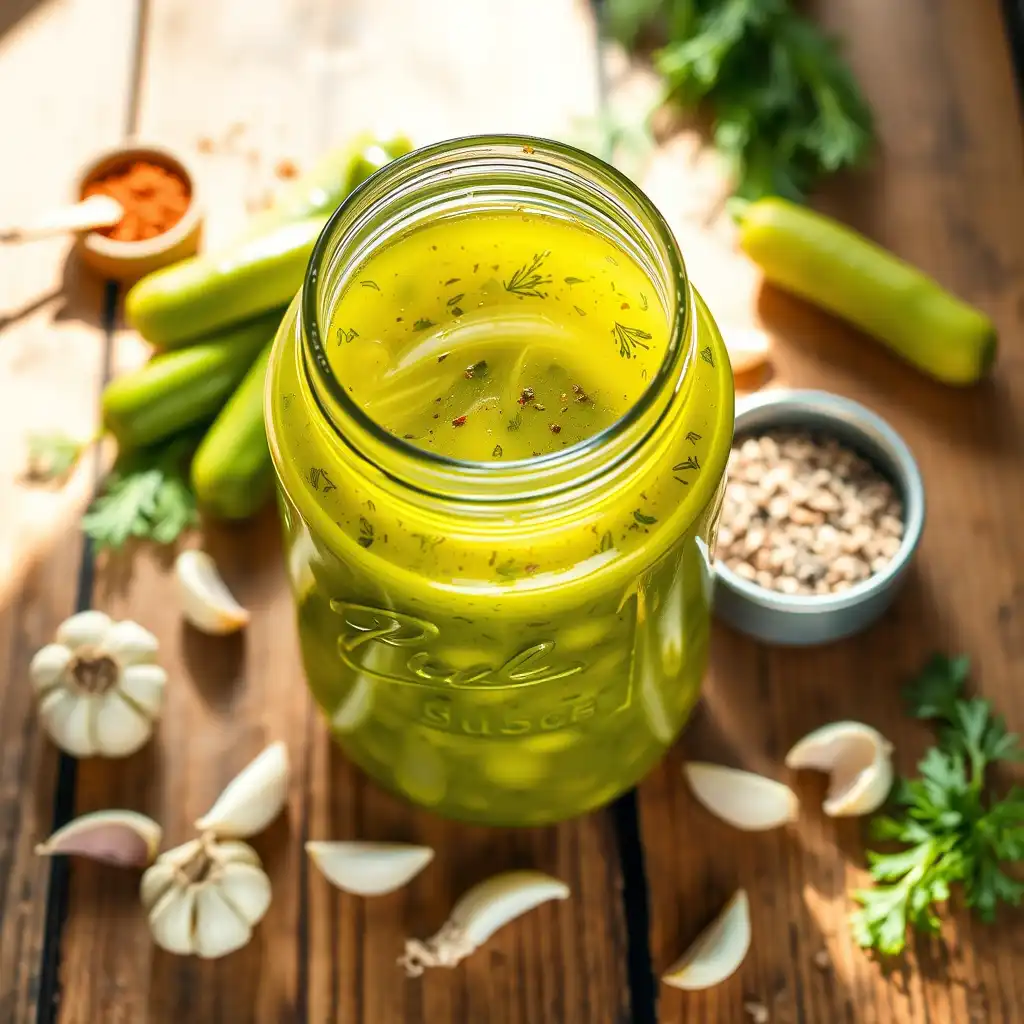Dill Pickle Hot Sauce isn’t your everyday condiment. I remember the first time I drizzled it over fried chicken—it hit with this tangy, briny kick that made my taste buds do a little dance. Most people think pickles are just for sandwiches, but blend that sharp vinegar tang with fiery peppers, and you get a sauce that’s unexpectedly addictive. This recipe is special because it fuses the crispness of fresh dill pickles with a carefully balanced heat, perfect for those who crave both tang and spice.
Ingredients & Substitutions
Dill Pickle Hot Sauce calls for some key players: fresh dill pickles, pickling juice, hot peppers (jalapeños or serranos work beautifully), garlic, onion, apple cider vinegar, and a touch of sugar. If fresh dill pickles aren’t around, high-quality jarred ones will do, but try to pick ones with minimal preservatives for a cleaner flavor. Want it milder? Swap jalapeños for banana peppers or even roasted poblanos. For sugar alternatives, honey or agave syrup works, though it changes the tang-to-sweet balance slightly. Choosing fresh garlic and onions gives a brighter punch; dehydrated powders will make the sauce taste flat and dull.
Step-by-Step Instructions
Dill Pickle Hot Sauce starts by roughly chopping the pickles, peppers, garlic, and onions. Toss everything in a saucepan with the vinegar, pickle juice, and sugar. Simmer gently—don’t boil aggressively, or the bright flavors get muted. Once softened, blend until smooth using an immersion blender or food processor. Taste, then tweak: more vinegar for tang, more peppers for heat. Bottle it hot, or let it rest a day for flavors to marry. Common mistake? Overcooking—your sauce can turn bitter and dull. Variations? Smoke the peppers first for a subtle smoky twist.
Cooking Techniques & Science
Dill Pickle Hot Sauce relies on simmering, not boiling, to meld flavors. Heat softens peppers and onions, releasing natural sugars that balance acidity. Vinegar isn’t just for taste—it preserves and intensifies flavors, making the sauce shelf-stable. Fermentation is another layer if you use naturally fermented pickles; the probiotics create umami depth you wouldn’t get otherwise. A blender’s speed matters too: over-blending can aerate the sauce, changing texture and mouthfeel, so pulse gently if you want a creamy but dense consistency.
Serving & Pairing Suggestions
Dill Pickle Hot Sauce is an absolute chameleon. Slather it on fried chicken, drizzle it over roasted veggies, or stir it into creamy dips for a tangy heat lift. Pair with crispy fries, grilled sausages, or even soft pretzels—the tang cuts through fat beautifully. Drinks? Hoppy beers and crisp white wines balance the briny spice. Presentation-wise, a small squeeze bottle on the table lets guests drizzle artfully, making your dish look chef-level without fuss.
Conclusion
Dill Pickle Hot Sauce takes simple ingredients and turns them into a culinary punch. The interplay of tangy, salty, and spicy is what makes it unforgettable. Remember: fresh ingredients, careful simmering, and proper balancing of vinegar and heat are the secrets. Don’t shy away from experimenting—smoked peppers, roasted garlic, or a touch of honey can tweak it to your style. Keep a jar handy; this sauce elevates almost anything.
FAQ
What type of pickles works best for Dill Pickle Hot Sauce?
Fresh, firm dill pickles with natural brine work best. Avoid overly soft or sweet pickles, as they can throw off balance.
Can I make this sauce vegan or gluten-free?
Absolutely. The basic recipe is naturally vegan and gluten-free. Just ensure your sugar or any added condiments comply.
How long does Dill Pickle Hot Sauce last?
Refrigerated in a sealed jar, it lasts 3–4 weeks. Fermented pickles may extend shelf-life due to natural acids.
Can I adjust the heat level?
Yes. Use fewer peppers for mild heat or swap in hotter varieties like serranos or habaneros for more kick.
Is it possible to can this sauce for long-term storage?
Yes, but proper hot water bath canning is required. Make sure acidity is high enough to prevent spoilage.

Olivia P. is a seasoned food blogger at Tastywink, sharing delicious, easy-to-follow recipes inspired by him passion for home cooking. With years of culinary blogging experience, he brings flavor, creativity, and a personal touch to every dish.
